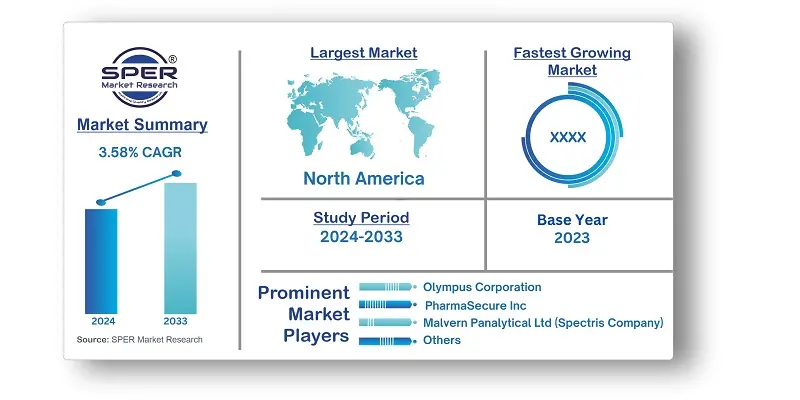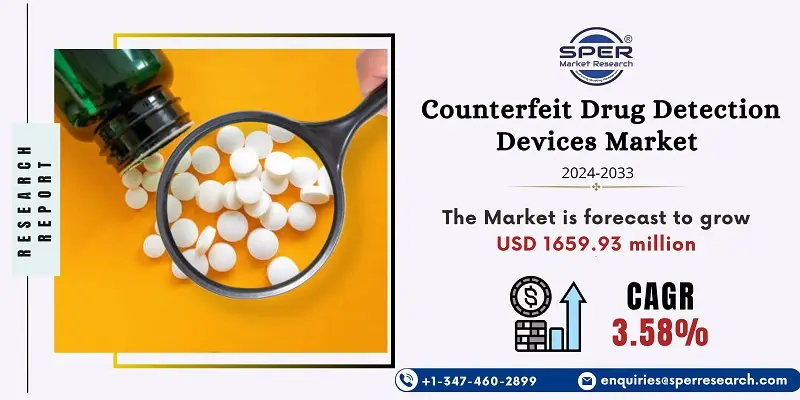
Counterfeit Drug Detection Devices Market Trends, Share, Demand, Revenue and Future Outlook
Counterfeit Drug Detection Devices Market Growth, Size, Trends Analysis- By Product, By Modality, By End User- Regional Outlook, Competitive Strategies and Segment Forecast to 2033
| Published: Nov-2024 | Report ID: MEDE2449 | Pages: 1 - 237 | Formats*: |
| Category : Medical Devices | |||
- February 2022: Avery Dennison Smartrac sent off its AD Minidose U9 Downpour RFID decorate for drug applications, opening basic RFID as an incentive for medical services, drug stores, and lab resources to the board.
- August 2021: Avery Dennison Corporation obtained Vestcom for a speculation of USD 1.45 billion. The obtaining will assist the organization with extending its marked naming contributions for the retail and shopper bundled products enterprises.


| Report Metric | Details |
| Market size available for years | 2020-2033 |
| Base year considered | 2023 |
| Forecast period | 2024-2033 |
| Segments covered | By Product, By Modality, By End Use |
| Regions covered | North America, Asia-Pacific, Latin America, Middle East & Africa and Europe |
| Companies Covered | B&W Tek, Malvern Panalytical Ltd (Spectris Company), Olympus Corporation, PharmaSecure Inc, RIGAKU CORPORATION, Thermo Fisher Scientific Inc and Veripad. |
- Pharmaceutical Manufacturers
- Healthcare Providers
- Regulatory Authorities
- Distributors and Wholesalers
- Consumers
- Research Institutions
- Technology Developers
| By Product: | |
| By Modality: | |
| By End Use: |
- Global Counterfeit Drug Detection Devices Market Size (FY’2024-FY’2033)
- Overview of Global Counterfeit Drug Detection Devices Market
- Segmentation of Global Counterfeit Drug Detection Devices Market by Product (Counterfeit Chemical Composition Detection Devices, Counterfeit Packaging and Labelling Detection Devices)
- Segmentation of Global Counterfeit Drug Detection Devices Market by Modality (Portable Devices, Handheld Devices, Benchtop Devices)
- Segmentation of Global Counterfeit Drug Detection Devices Market by End Use (Pharmaceutical Companies, Drug Testing Laboratories, Research Organizations and others)
- Statistical Snap of Global Counterfeit Drug Detection Devices Market
- Expansion Analysis of Global Counterfeit Drug Detection Devices Market
- Problems and Obstacles in Global Counterfeit Drug Detection Devices Market
- Competitive Landscape in the Global Counterfeit Drug Detection Devices Market
- Impact of COVID-19 and Demonetization on Global Counterfeit Drug Detection Devices Market
- Details on Current Investment in Global Counterfeit Drug Detection Devices Market
- Competitive Analysis of Global Counterfeit Drug Detection Devices Market
- Prominent Players in the Global Counterfeit Drug Detection Devices Market
- SWOT Analysis of Global Counterfeit Drug Detection Devices Market
- Global Counterfeit Drug Detection Devices Market Future Outlook and Projections (FY’2024-FY’2033)
- Recommendations from Analyst
1.1. Scope of the report1.2. Market segment analysis
2.1. Research data source2.1.1. Secondary Data2.1.2. Primary Data2.1.3. SPER’s internal database2.1.4. Premium insight from KOL’s2.2. Market size estimation2.2.1. Top-down and Bottom-up approach2.3. Data triangulation
4.1. Driver, Restraint, Opportunity and Challenges analysis4.1.1. Drivers4.1.2. Restraints4.1.3. Opportunities4.1.4. Challenges4.2. COVID-19 Impacts of the Global Counterfeit Drug Detection Devices Market.
5.1. SWOT Analysis5.1.1. Strengths5.1.2. Weaknesses5.1.3. Opportunities5.1.4. Threats5.2. PESTEL Analysis5.2.1. Political Landscape5.2.2. Economic Landscape5.2.3. Social Landscape5.2.4. Technological Landscape5.2.5. Environmental Landscape5.2.6. Legal Landscape5.3. PORTER’s Five Forces5.3.1. Bargaining power of suppliers5.3.2. Bargaining power of buyers5.3.3. Threat of Substitute5.3.4. Threat of new entrant5.3.5. Competitive rivalry5.4. Heat Map Analysis
6.1. Global Counterfeit Drug Detection Devices Market Manufacturing Base Distribution, Sales Area, Product Type6.2. Mergers & Acquisitions, Partnerships, Product Launch, and Collaboration in Global Counterfeit Drug Detection Devices Market
7.1. Global Counterfeit Drug Detection Devices Market Size, Share and Forecast, By Product, 2020-20267.2. Global Counterfeit Drug Detection Devices Market Size, Share and Forecast, By Product, 2027-20337.3. Counterfeit Chemical Composition Detection Devices7.4. Counterfeit Packaging and Labelling Detection Devices
8.1. Global Counterfeit Drug Detection Devices Market Size, Share and Forecast, By Modality, 2020-20268.2. Global Counterfeit Drug Detection Devices Market Size, Share and Forecast, By Modality, 2027-20338.3. Portable Devices8.4. Handheld Devices8.5. Benchtop Devices
9.1. Global Counterfeit Drug Detection Devices Market Size, Share and Forecast, By End Use, 2020-20269.2. Global Counterfeit Drug Detection Devices Market Size, Share and Forecast, By End Use, 2027-20339.3. Pharmaceutical Companies9.4. Drug Testing Laboratories9.5. Research Organizations9.6. Others
10.1. Global Counterfeit Drug Detection Devices Market Size and Market Share
11.1. Global Counterfeit Drug Detection Devices Market Size and Market Share By Region (2020-2026)11.2. Global Counterfeit Drug Detection Devices Market Size and Market Share By Region (2027-2033)11.3. Asia-Pacific11.3.1. Australia11.3.2. China11.3.3. India11.3.4. Japan11.3.5. South Korea11.3.6. Rest of Asia-Pacific11.4. Europe11.4.1. France11.4.2. Germany11.4.3. Italy11.4.4. Spain11.4.5. United Kingdom11.4.6. Rest of Europe11.5. Middle East and Africa11.5.1. Kingdom of Saudi Arabia11.5.2. United Arab Emirates11.5.3. Qatar11.5.4. South Africa11.5.5. Egypt11.5.6. Morocco11.5.7. Nigeria11.5.8. Rest of Middle-East and Africa11.6. North America11.6.1. Canada11.6.2. Mexico11.6.3. United States11.7. Latin America11.7.1. Argentina11.7.2. Brazil11.7.3. Rest of Latin America
12.1. B&W Tek12.1.1. Company details12.1.2. Financial outlook12.1.3. Product summary12.1.4. Recent developments12.2. Malvern Panalytical Ltd (Spectris Company)12.2.1. Company details12.2.2. Financial outlook12.2.3. Product summary12.2.4. Recent developments12.3. Olympus Corporation12.3.1. Company details12.3.2. Financial outlook12.3.3. Product summary12.3.4. Recent developments12.4. PharmaSecure Inc12.4.1. Company details12.4.2. Financial outlook12.4.3. Product summary12.4.4. Recent developments12.5. RIGAKU CORPORATION12.5.1. Company details12.5.2. Financial outlook12.5.3. Product summary12.5.4. Recent developments12.6. Thermo Fisher Scientific Inc12.6.1. Company details12.6.2. Financial outlook12.6.3. Product summary12.6.4. Recent developments12.7. Veripad12.7.1. Company details12.7.2. Financial outlook12.7.3. Product summary12.7.4. Recent developments12.8. Others
SPER Market Research’s methodology uses great emphasis on primary research to ensure that the market intelligence insights are up to date, reliable and accurate. Primary interviews are done with players involved in each phase of a supply chain to analyze the market forecasting. The secondary research method is used to help you fully understand how the future markets and the spending patterns look likes.
The report is based on in-depth qualitative and quantitative analysis of the Product Market. The quantitative analysis involves the application of various projection and sampling techniques. The qualitative analysis involves primary interviews, surveys, and vendor briefings. The data gathered as a result of these processes are validated through experts opinion. Our research methodology entails an ideal mixture of primary and secondary initiatives.



Frequently Asked Questions About This Report
PLACE AN ORDER
Year End Discount
Sample Report
Pre-Purchase Inquiry
NEED CUSTOMIZATION?
Request CustomizationCALL OR EMAIL US
100% Secure Payment






Related Reports
Our Global Clients
Our data-driven insights have influenced the strategy of 200+ reputed companies across the globe.




















